Coupling Coordination Development of the Ecological–Economic System in Hangzhou, China
Abstract
:1. Introduction
- (1)
- To evaluate the spatiotemporal characteristics of economic development system and ecological environment system in the four study areas of Hangzhou from 2010 to 2020;
- (2)
- To analyze the spatiotemporal evolution characteristics of the coupling coordination relationship between economic development system and ecological environment system in Hangzhou from 2010 to 2020;
- (3)
- To examine the changes in the spatial pattern of landscape morphology in Hangzhou from 2010 to 2020;
- (4)
- To investigate whether changes in the coupling coordination degree of Hangzhou’s ecological–economic system from 2010 to 2020 can be reciprocally validated by alterations in the spatial pattern of landscape morphology.
2. Research Theory, Methods and Data
2.1. Coupling Mechanism of Ecological Environment and Economic Development
2.2. Methods
2.2.1. Comprehensive Level Evaluation Model
- (1)
- The proportion of each standardized index was calculated:
- (2)
- The information entropy of the j-th index was calculated:
- (3)
- The information utility value of the j-th index was calculated:
- (4)
- The weight of the j-th index was calculated:
2.2.2. Coupling Coordination Model
2.2.3. Morphological Spatial Pattern Analysis
2.3. Index System and Data Sources
2.3.1. Construction of Index System
2.3.2. Data Sources
2.3.3. Descriptive Statistical Analysis
3. Research Result
3.1. Overview of the Study Area
3.2. Subsystem Exponential Spatiotemporal Characteristics
3.2.1. Timing Changes
3.2.2. Spatial Features
3.3. Spatiotemporal Differentiation Characteristics of CCD
3.3.1. Timing Changes
3.3.2. Spatial Differentiation Characteristics
3.4. Changes in the Morphological Spatial Pattern of Hangzhou City
4. Discussion
5. Conclusions and Policy Implications
5.1. Conclusions
5.2. Policy Recommendations
Author Contributions
Funding
Institutional Review Board Statement
Informed Consent Statement
Data Availability Statement
Conflicts of Interest
References
- Anand, J.; Gosain, A.K.; Khosa, R. Prediction of land use changes based on Land Change Modeler and attribution of changes in the water balance of Ganga basin to land use change using the SWAT model. Sci. Total Environ. 2018, 644, 503–519. [Google Scholar] [CrossRef]
- Venticinque, E.; Forsberg, B.; Barthem, R.; Petry, P.; Hess, L.; Mercado, A.; Canas, C.; Montoya, M.; Durigan, C.; Goulding, M. An explicit GIS-based river basin framework for aquatic ecosystem conservation in the Amazon. Earth Syst. Sci. Data 2016, 8, 651–661. [Google Scholar] [CrossRef]
- De Graaff, J.; Amsalu, A.; Bodnar, F.; Kessler, A.; Posthumus, H.; Tenge, A. Factors influencing adoption and continued use of long-term soil and water conservation measures in five developing countries. Appl. Geogr. 2008, 28, 271–280. [Google Scholar] [CrossRef]
- Cooke, J.; Johnson, M. Ecological restoration of land with particular reference to the mining of metals and industrial minerals: A review of theory and practice. Environ. Rev. 2002, 10, 41–71. [Google Scholar] [CrossRef]
- Fischer, L.K.; von der Lippe, M.; Rillig, M.C.; Kowarik, I. Creating novel urban grasslands by reintroducing native species in wasteland vegetation. Biol. Conserv. 2013, 159, 119–126. [Google Scholar] [CrossRef]
- Thompson, D.G.; Pitt, D.G. A review of Canadian forest vegetation management research and practice. Ann. For. Sci. 2003, 60, 559–572. [Google Scholar] [CrossRef]
- Myers, N.; Mittermeier, R.A.; Mittermeier, C.G.; Da Fonseca, G.A.; Kent, J. Biodiversity hotspots for conservation priorities. Nature 2000, 403, 853–858. [Google Scholar] [CrossRef]
- Tamayo, U.; Vargas, G. Biomimetic economy: Human ecological-economic systems emulating natural ecological systems. Soc. Responsib. J. 2019, 15, 772–785. [Google Scholar] [CrossRef]
- Qiu, M.; Zuo, Q.T.; Wu, Q.S.; Yang, Z.L.; Zhang, J.W. Water ecological security assessment and spatial autocorrelation analysis of prefectural regions involved in the Yellow River Basin. Sci. Rep. 2022, 12, 5105. [Google Scholar] [CrossRef]
- Liu, Y.; Zhou, X.; Zhang, Q.Y.; Zeng, L.X.; Kang, Y.; Luo, J.W. Study on sustainable developments in Guangdong Province from 2013 to 2018 based on an improved ecological footprint model. Sci. Rep. 2022, 12, 2310. [Google Scholar] [CrossRef]
- Mao, F.; Miller, J.D.; Young, S.L.; Krause, S.; Hannah, D.M. Inequality of household water security follows a Development Kuznets Curve. Nat. Commun. 2022, 13, 4525. [Google Scholar] [CrossRef]
- Grossman, G.M.; Krueger, A.B. Environmental Impacts of a North American Free Trade Agreement; National Bureau of Economic Research: Cambridge, MA, USA, 1991. [Google Scholar]
- Dogan, E.; Inglesi-Lotz, R. The impact of economic structure to the environmental Kuznets curve (EKC) hypothesis: Evidence from European countries. Environ. Sci. Pollut. Res. 2020, 27, 12717–12724. [Google Scholar] [CrossRef]
- Chen, S.; Saleem, N.; Bari, M.W. Financial development and its moderating role in environmental Kuznets curve: Evidence from Pakistan. Environ. Sci. Pollut. Res. 2019, 26, 19305–19319. [Google Scholar]
- Yan, G.Q.; He, Y.C.; Zhang, X.H. Green technological progress, agricultural economic growth and pollution space spillovers: Evidence from the use of agricultural water resources in China. Yangtze River Basin Resour. Environ. 2019, 28, 2921–2935. [Google Scholar]
- Zhang, Q.Y.; Zhang, Y.L.; Pan, B.B. An analysis of the influencing factors of China’s economic growth and carbon emissions in the 40 years of reform and opening. Arid Area Resour. Environ. 2019, 33, 9–13. [Google Scholar]
- Liu, K.; Qiao, Y.R.; Shi, T.; Zhou, Q. Study on coupling coordination and spatiotemporal heterogeneity between economic development and ecological environment of cities along the Yellow River Basin. Environ. Sci. Pollut. Res. 2021, 28, 6898–6912. [Google Scholar] [CrossRef]
- Cui, P.P.; Zhao, Y.; Xia, S.Y.; Yan, J.Y. Level measures and temporal and spatial coupling analysis of ecological environment and high quality development in the Yellow River Basin. Econ. Geogr. 2020, 40, 49–57+80. [Google Scholar]
- Chu, Y.; Fu, J.B.; Chen, H.J. Temporal and spatial evolution of the coupling coordination of the high-quality development of regional ecological environment and economy: Taking Henan province for example. Ecol. Econ. 2022, 38, 161–168. [Google Scholar]
- Feng, Y.J.; Zhu, A.K.; Liu, P.; Liu, Z.L. Coupling and coordinated relationship of water utilization, industrial development and ecological welfare in the Yellow River Basin, China. J. Clean. Prod. 2022, 379, 134824. [Google Scholar] [CrossRef]
- Zhang, Z.Q.; Lao, Y.L.; Hu, B.Q.; Wei, J.H. Understanding the coupling coordination mechanism between urbanization and territorial spatial ecological restoration in “revolutionary-minority-border-montanic-poverty” regions. J. Agric. Resour. Environ. 2020, 37, 882–893. [Google Scholar]
- Wei, W.; Shi, P.J.; Wei, X.X.; Zhou, J.J.; Xie, B.B. Evaluation of the coordinated development of economy and eco-environmental systems and spatial evolution in China. Acta Ecol. Sin. 2018, 38, 2636–2648. [Google Scholar]
- He, W.J.; Yang, M.; Yuan, L.; Lv, Y.Y.; Cui, Y. Ecological and economic evaluation of Wuling Mountain area using the entropy method. Ecol. Sci. 2016, 35, 143–149. [Google Scholar]
- Xiang, J.W.; Wan, S.; Hu, S.G. Research on factor contribution degree of coordinated development in Wuhan’s eco-economic system. J. China Univ. Geosci. (Soc. Sci. Ed.) 2015, 15, 30–36+167–168. [Google Scholar]
- Wang, Z.; Liu, J.H.; Li, T.S.; Ruan, Z.; Wu, F.Q. Analysis of the coupling relationship between ecological vulnerability and economic poverty in Qinling-Dabashan contiguous poor areas: A case study of Shanyang County in Shaanxi Province, China. Acta Ecol. Sin. 2019, 39, 3908–3917. [Google Scholar]
- Sun, Y.; Cheng, Q.G.; Li, Y.; Fu, J. Assessment of eco-economic system sustainable development of Liaoning Province based on emergy analysis. Chin. J. Appl. Ecol. 2014, 25, 188–194. [Google Scholar]
- Liu, C.L.; Yan, Q.; Luo, J. System dynamics simulation on the coupling of economy resources environment system in Wuhan Metropolitan Region. Geogr. Res. 2013, 32, 857–869. [Google Scholar]
- Zhang, Q.; Shen, J.; Sun, F. Spatiotemporal differentiation of coupling coordination degree between economic development and water environment and its influencing factors using GWR in China’s province. Ecol. Model. 2021, 462, 109794. [Google Scholar] [CrossRef]
- Zhang, K.; Dong, Z.; Guo, L.; Boyer, E.W.; Liu, J.; Chen, J.; Fan, B. Coupled coordination spatiotemporal analyses inform sustainable development and environmental protection for the Yellow River Basin of China. Ecol. Indic. 2023, 151, 110283. [Google Scholar] [CrossRef]
- Hein, L.; Van Koppen, K.; De Groot, R.S.; Van Ierland, E.C. Spatial scales, stakeholders and the valuation of ecosystem services. Ecol. Econ. 2006, 57, 209–228. [Google Scholar] [CrossRef]
- Hein, L.; van Koppen, C.K.; van Ierland, E.C.; Leidekker, J. Temporal scales, ecosystem dynamics, stakeholders and the valuation of ecosystems services. Ecosyst. Serv. 2016, 21, 109–119. [Google Scholar] [CrossRef]
- Cisneros-Montemayor, A.M.; Moreno-Báez, M.; Reygondeau, G.; Cheung, W.W.; Crosman, K.M.; González-Espinosa, P.C.; Lam, V.W.; Oyinlola, M.A.; Singh, G.G.; Swartz, W. Enabling conditions for an equitable and sustainable blue economy. Nature 2021, 591, 396–401. [Google Scholar] [CrossRef]
- Xiao, L.M.; Zhang, X.P. Spatio-temporal characteristics of coupling coordination between green innovation efficiency and ecological welfare performance under the concept of strong sustainability. J. Nat. Resour. 2019, 34, 312–324. [Google Scholar] [CrossRef]
- Shi, T.; Yang, S.Y.; Zhang, W.; Zhou, Q. Coupling coordination degree measurement and spatiotemporal heterogeneity between economic development and ecological environment—Empirical evidence from tropical and subtropical regions of China. J. Clean. Prod. 2020, 244, 118739. [Google Scholar] [CrossRef]
- Fang, C.L.; Zhou, C.H.; Gu, C.L.; Chen, L.D.; Li, S.C. Theoretical analysis of interactive coupled effects between urbanization and eco-environment in mega-urban agglomerations. Acta Geogr. Sin. 2016, 71, 531–550. [Google Scholar] [CrossRef]
- Wang, S.J.; Kong, W.; Ren, L.; Zhi, D.D.; Dai, B.T. Research on misuses and modification of coupling coordination degree model in China. J. Nat. Resour. 2021, 36, 793–810. [Google Scholar] [CrossRef]
- Soille, P.; Vogt, P. Morphological segmentation of binary patterns. Pattern Recognit. Lett. 2009, 30, 456–459. [Google Scholar] [CrossRef]
- Iwanowski, M. Morphological classification of binary image pixels. Mach. Graph. Vis. 2009, 18, 155–173. [Google Scholar]
- Han, D.; Yu, D.; Qiu, J. Assessing coupling interactions in a safe and just operating space for regional sustainability. Nat. Commun. 2023, 14, 1369. [Google Scholar] [CrossRef] [PubMed]
- Yang, P.F.; Jiao, Z.F. Application of coupling method of eco-socioeconomic system in national territory spatial ecological restoration planning system of counties: A case study of Weiyuan county. J. Nat. Resour. 2021, 36, 2308–2319. [Google Scholar]
- Gao, Q.; Pan, R.; Yang, Y.D.; Jiang, D.G. Territory space use governance system at city level, Hangzhou. Planners 2021, 37, 49–54. [Google Scholar]
- Li, D.L.; Cao, L.J.; Zhou, Z.H.; Zhao, K.K.; Du, Z.N.; Han, K.Q. Coupling coordination degree and driving factors of new-type urbanization and low-carbon development in the Yangtze River Delta: Based on nighttime light data. Environ. Sci. Pollut. Res. 2022, 29, 81636–81657. [Google Scholar] [CrossRef] [PubMed]
- Li, T.N.; Li, D.Z.; Liang, D.L.; Huang, S.M. Coupling coordination degree of ecological-economic and its influencing factors in the counties of Yangtze River Economic Belt. Sustainability 2022, 14, 15467. [Google Scholar] [CrossRef]
- Li, J.S.; Sun, W.; Li, M.Y.; Meng, L.L. Coupling coordination degree of production, living and ecological spaces and its influencing factors in the Yellow River Basin. J. Clean. Prod. 2021, 298, 126803. [Google Scholar] [CrossRef]
- Wu, Y.; Tam, V.W.; Shuai, C.Y.; Shen, L.Y.; Zhang, Y.; Liao, S.J. Decoupling China’s economic growth from carbon emissions: Empirical studies from 30 Chinese provinces (2001–2015). Sci. Total Environ. 2019, 656, 576–588. [Google Scholar] [CrossRef] [PubMed]
- Shang, Y.F.; Zhu, L.R.; Qian, F.B.; Xie, Y.N. Role of green finance in renewable energy development in the tourism sector. Renew. Energy 2023, 206, 890–896. [Google Scholar] [CrossRef]
- Tao, D.K.; Zhou, W.L. An Evaluation and Optimization of Green Development Strategy for the Nanjing-Hangzhou Eco-Economic Zone in China. Sustainability 2022, 14, 17002. [Google Scholar] [CrossRef]
- Zhao, Z.Y.; Wang, H.R.; Zhang, L.; Liu, X. Synergetic Development of “Water Resource-Water Environment-Socioeconomic Development” Coupling System in the Yangtze River Economic Belt. Water 2022, 14, 2851. [Google Scholar] [CrossRef]
- Fan, Y.P.; Fang, C.L.; Zhang, Q. Coupling coordinated development between social economy and ecological environment in Chinese provincial capital cities-assessment and policy implications. J. Clean. Prod. 2019, 229, 289–298. [Google Scholar] [CrossRef]




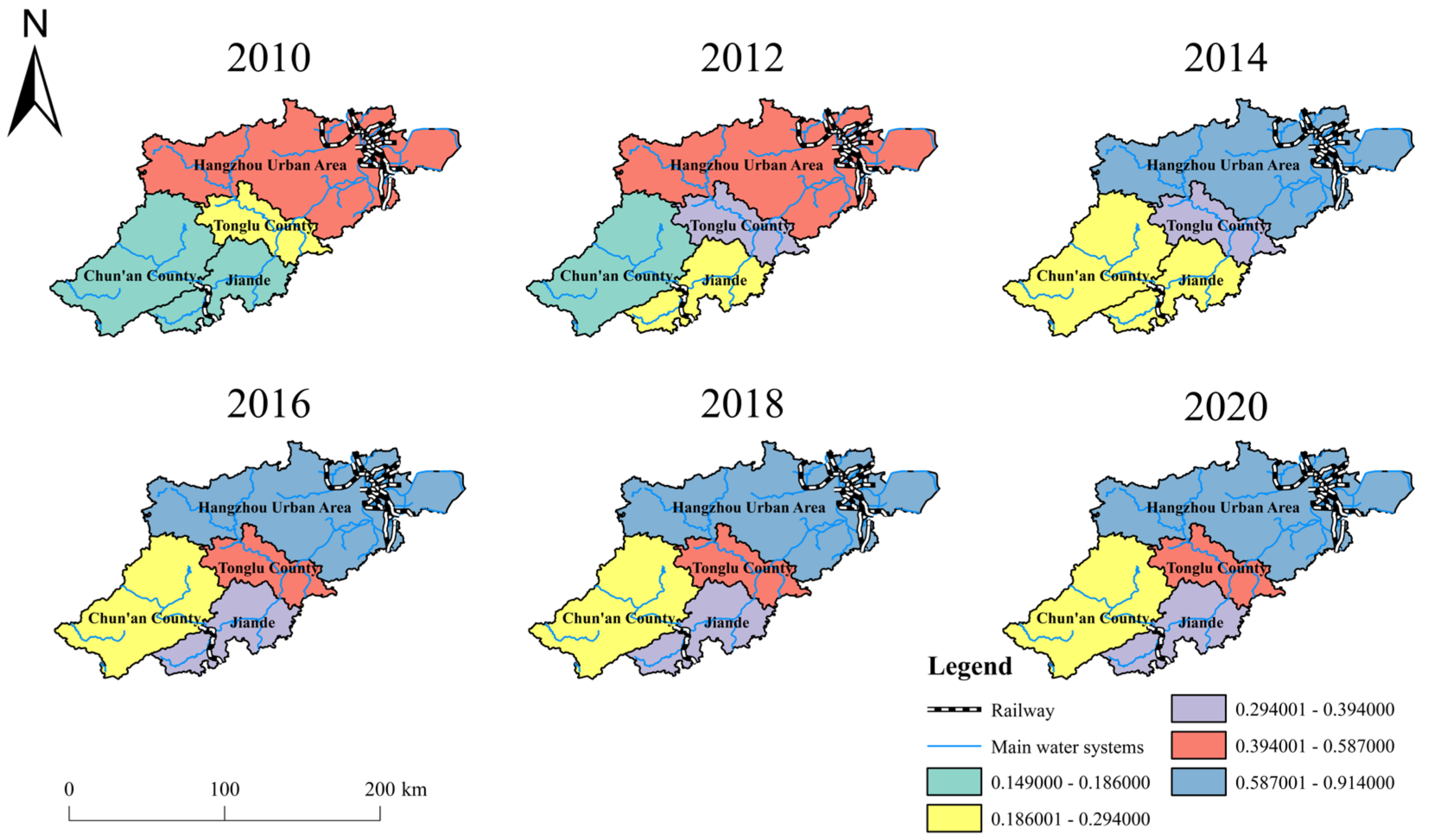

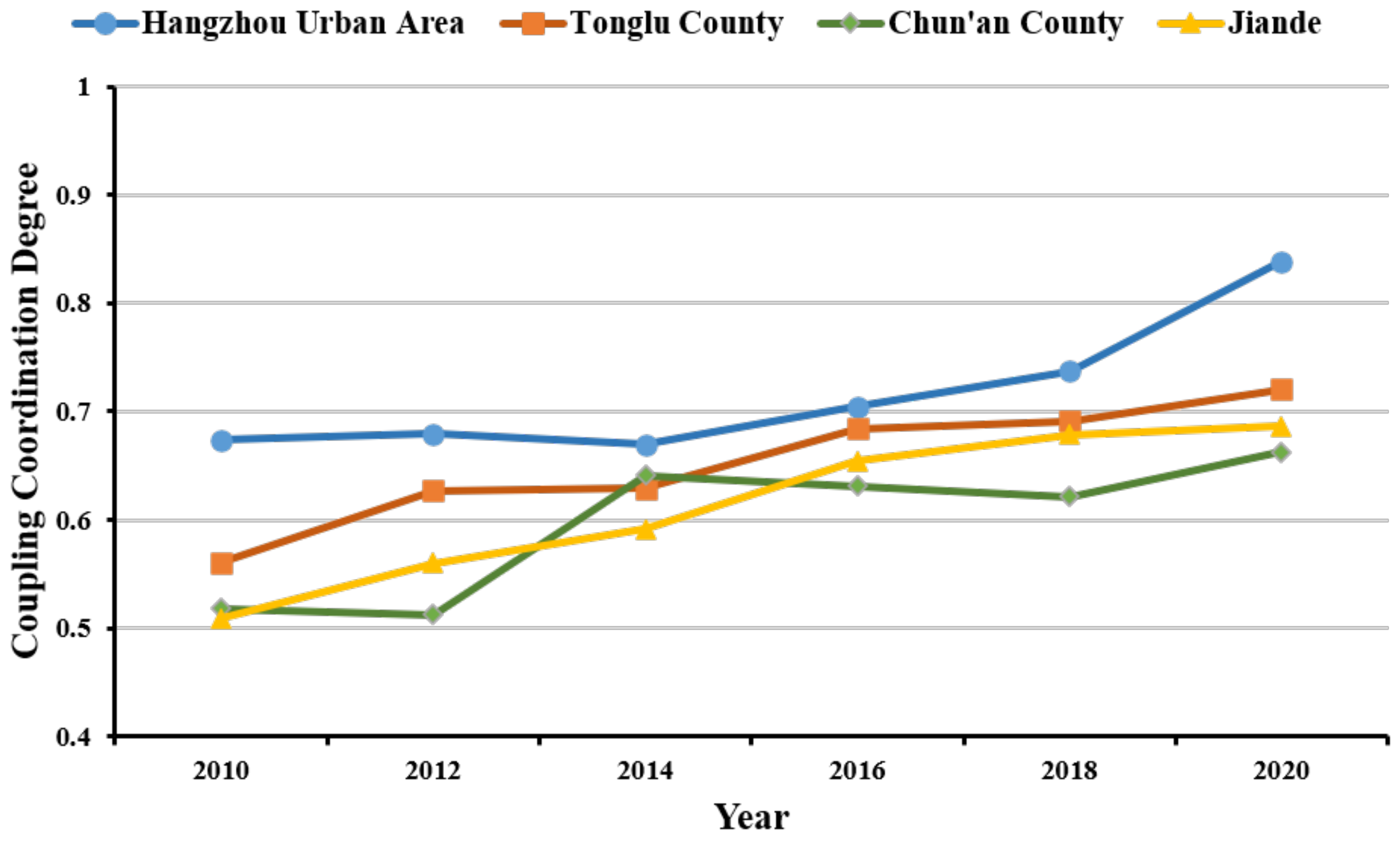
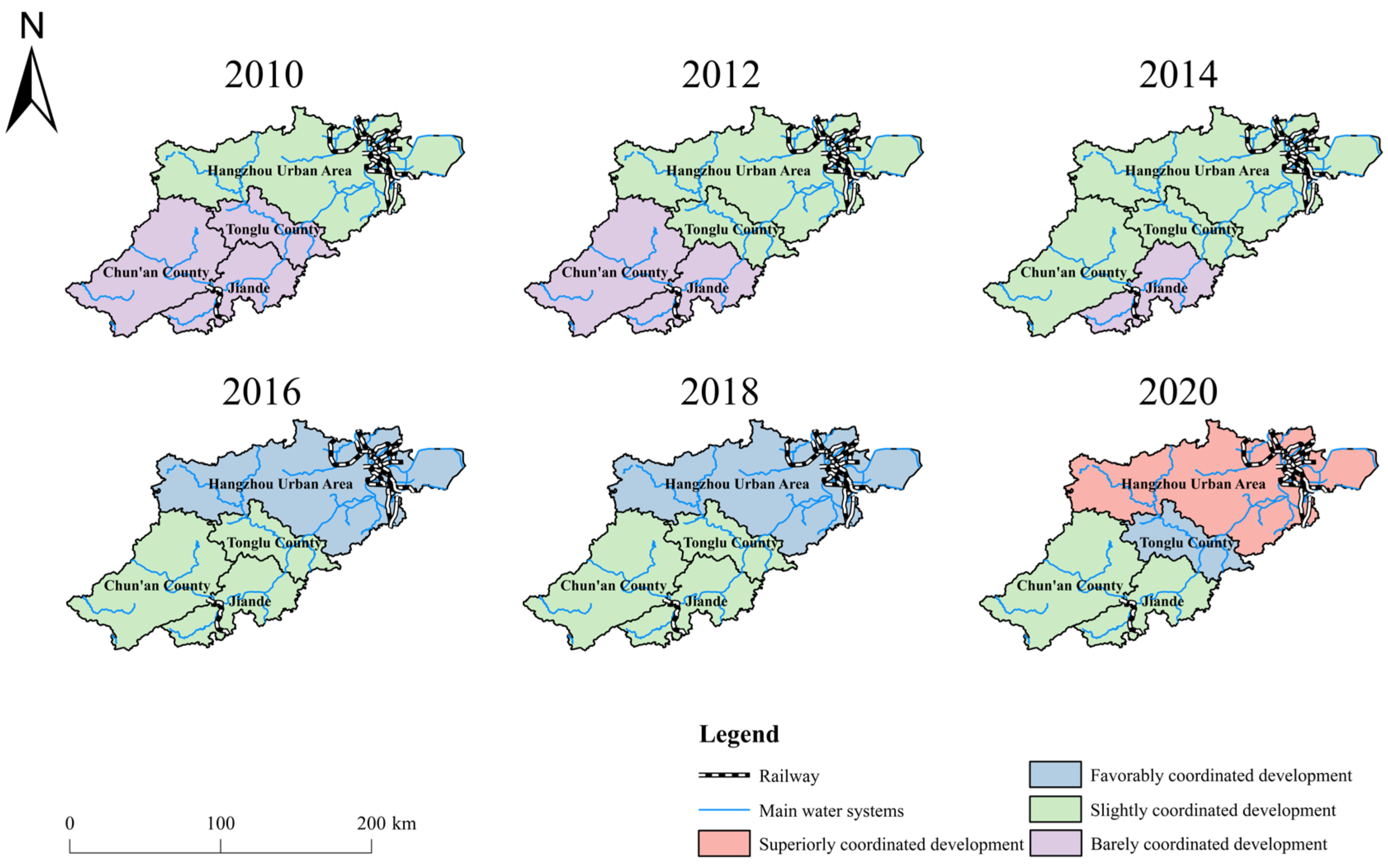
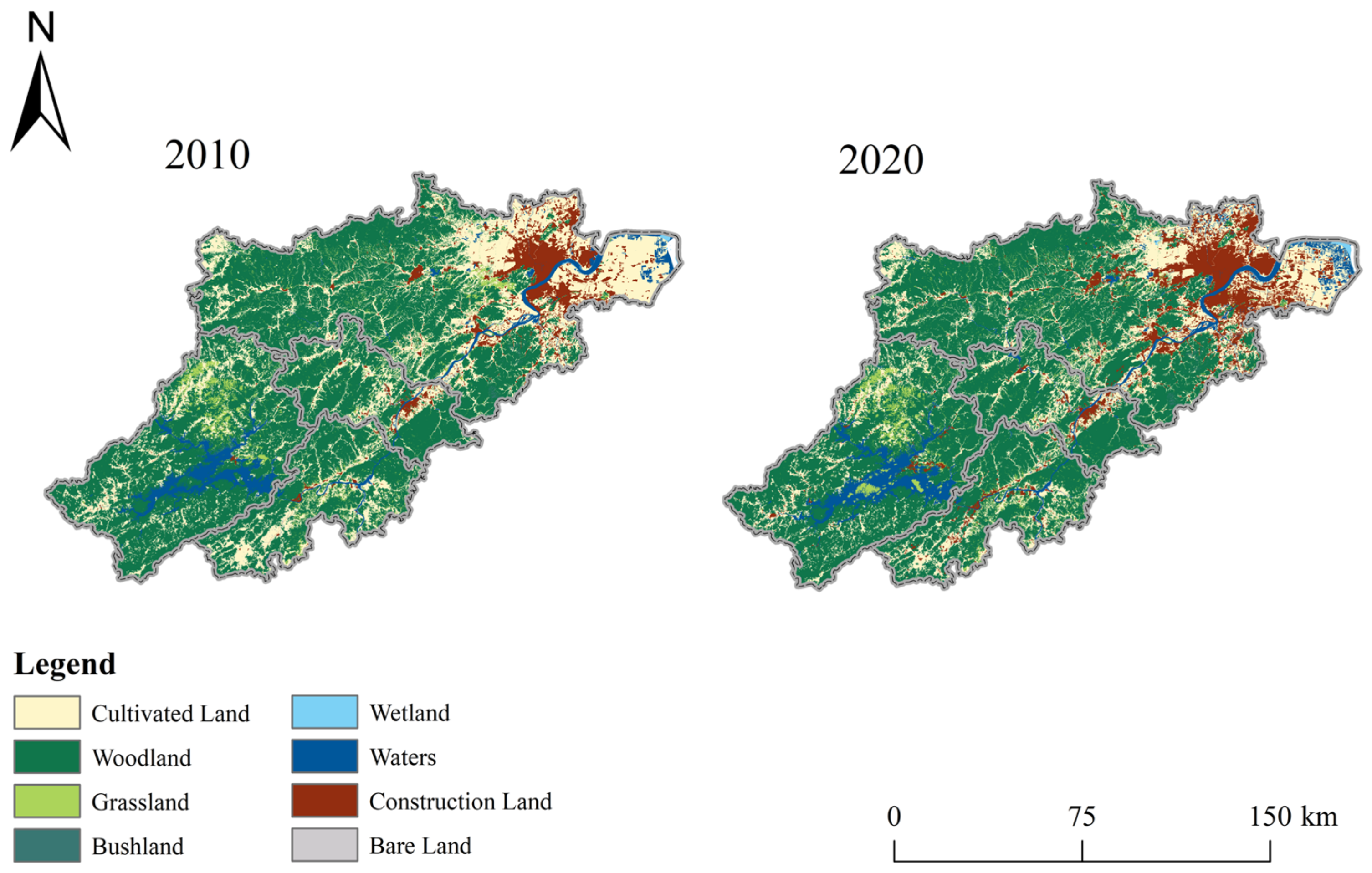
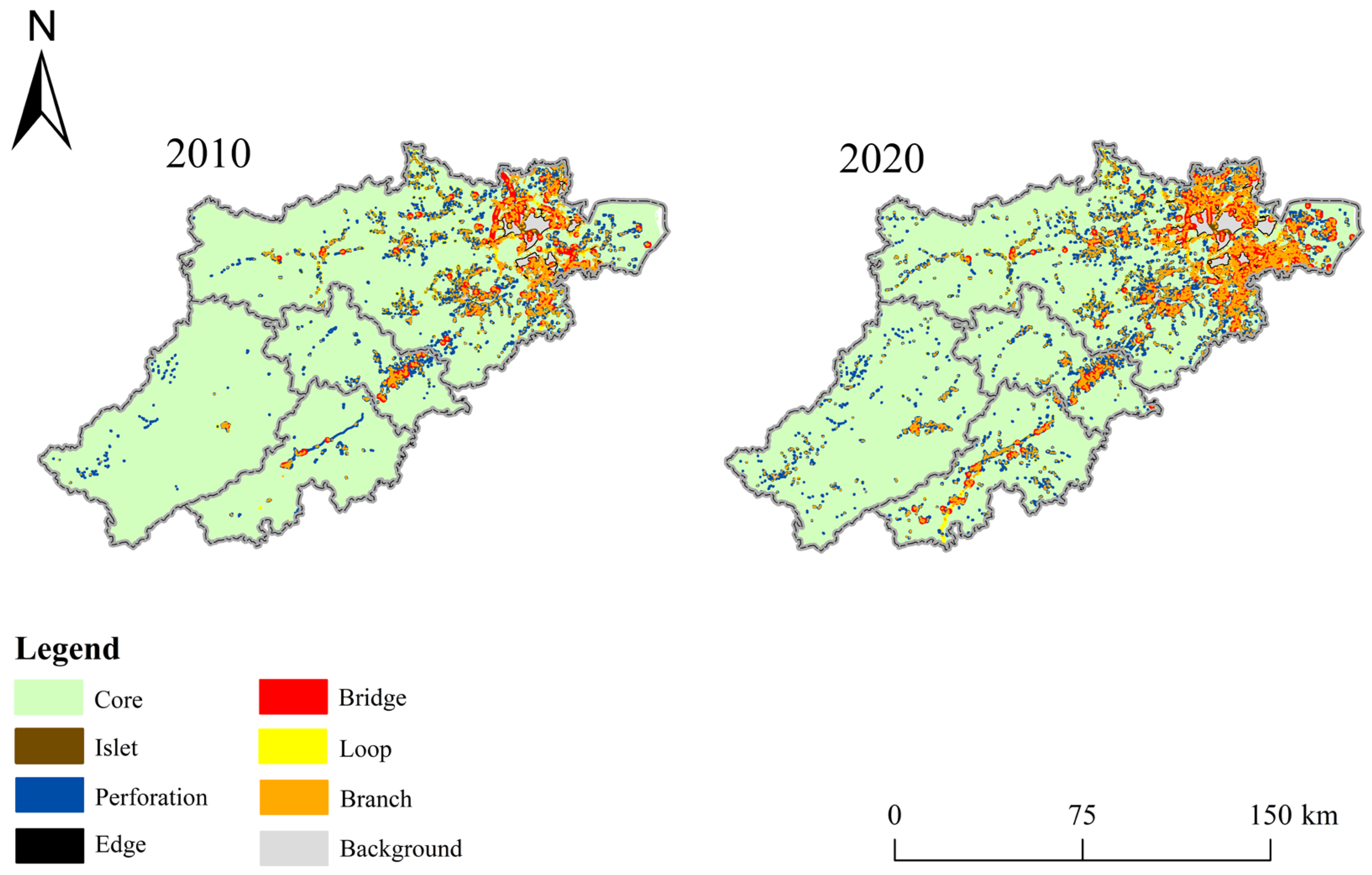
| First Classification | Second Classification | |
|---|---|---|
| D | Coupling Coordination Level | |
| Low coupling coordination | [0, 0.3] | Seriously uncoordinated development |
| Moderate coupling coordination | (0.3, 0.4] | Moderately uncoordinated development |
| (0.4, 0.5] | Slightly uncoordinated development | |
| High coupling coordination | (0.5, 0.6] | Barely coordinated development |
| (0.6, 0.7] | Slightly coordinated development | |
| (0.7, 0.8] | Favorably coordinated development | |
| Extreme coupling coordination | (0.8, 1.0] | Superiorly coordinated development |
| System | First Level Indices | Secondary Level Indices | Unit | Index Code | Weight |
|---|---|---|---|---|---|
| Economic development system | Economic scale | GDP per capita | CNY/person | X1 | 0.153 |
| Local fiscal revenue per capita | CNY/person | X2 | 0.285 | ||
| GDP growth rate | % | X3 | 0.033 | ||
| Per capita disposable income | CNY | X4 | 0.131 | ||
| Economic structure | Second industry GDP growth rate | % | X5 | 0.030 | |
| Tertiary industry GDP growth rate | % | X6 | 0.050 | ||
| Economic benefit | Reduction rate of energy consumption per unit GDP | % | X7 | 0.085 | |
| Water consumption per 10,000 yuan of GDP | cubic meters/CNY 10,000 | X8 | 0.071 | ||
| Urbanization rate | % | X9 | 0.162 | ||
| Ecological environment system | Ecological status | Forest cover rate | % | Y1 | 0.127 |
| Centralized treatment rate of urban domestic sewage | % | Y2 | 0.128 | ||
| Comprehensive utilization rate of general industrial solid waste | % | Y3 | 0.103 | ||
| Proportion of rivers with Class I and II water quality | % | Y4 | 0.072 | ||
| Number of days with good ambient air | day | Y5 | 0.056 | ||
| Environmental construction | Green coverage rate of built-up areas | % | Y6 | 0.142 | |
| Park green space per capita | square meters | Y7 | 0.140 | ||
| Proportion of environmental protection investment in public budget expenditure | % | Y8 | 0.232 |
| System Type | Region | 2010 | 2012 | 2014 | 2016 | 2018 | 2020 |
|---|---|---|---|---|---|---|---|
| Economic development System | Hangzhou Urban Area | 0.503 | 0.587 | 0.681 | 0.791 | 0.863 | 0.914 |
| Tonglu County | 0.266 | 0.336 | 0.394 | 0.445 | 0.493 | 0.483 | |
| Chun’an County | 0.149 | 0.186 | 0.264 | 0.294 | 0.267 | 0.241 | |
| Jiande | 0.173 | 0.247 | 0.274 | 0.372 | 0.346 | 0.359 | |
| Ecological environment System | Hangzhou Urban Area | 0.410 | 0.362 | 0.295 | 0.311 | 0.343 | 0.540 |
| Tonglu County | 0.371 | 0.460 | 0.398 | 0.493 | 0.464 | 0.557 | |
| Chun’an County | 0.484 | 0.373 | 0.639 | 0.541 | 0.558 | 0.799 | |
| Jiande | 0.387 | 0.399 | 0.448 | 0.493 | 0.614 | 0.618 |
| Region | 2010 | 2012 | 2014 | 2016 | 2018 | 2020 |
|---|---|---|---|---|---|---|
| Hangzhou Urban Area | 0.674 | 0.679 | 0.669 | 0.704 | 0.737 | 0.838 |
| Tonglu County | 0.560 | 0.627 | 0.629 | 0.684 | 0.691 | 0.720 |
| Chun’an County | 0.518 | 0.513 | 0.641 | 0.631 | 0.621 | 0.662 |
| Jiande | 0.509 | 0.560 | 0.592 | 0.654 | 0.679 | 0.686 |
| Landscape Type | 2010 | 2020 | ||
|---|---|---|---|---|
| Area (hm2) | Proportion of Study Area | Area (hm2) | Proportion of Study Area | |
| Core | 1,573,179.39 | 93.485% | 1,510,266.24 | 89.545% |
| Islet | 115.74 | 0.007% | 112.14 | 0.007% |
| Loop | 416.34 | 0.025% | 496.08 | 0.029% |
| Bridge | 183.15 | 0.011% | 462.78 | 0.027% |
| Perforation | 11,342.07 | 0.674% | 18,766.53 | 1.113% |
| Edge | 5944.68 | 0.353% | 9272.52 | 0.550% |
| Branch | 1511.73 | 0.090% | 2684.34 | 0.159% |
| Background | 90,121.95 | 5.355% | 144,530.46 | 8.569% |
Disclaimer/Publisher’s Note: The statements, opinions and data contained in all publications are solely those of the individual author(s) and contributor(s) and not of MDPI and/or the editor(s). MDPI and/or the editor(s) disclaim responsibility for any injury to people or property resulting from any ideas, methods, instructions or products referred to in the content. |
© 2023 by the authors. Licensee MDPI, Basel, Switzerland. This article is an open access article distributed under the terms and conditions of the Creative Commons Attribution (CC BY) license (https://creativecommons.org/licenses/by/4.0/).
Share and Cite
Ni, J.; Zheng, X.; Zheng, Y.; Zhang, Y.; Li, H. Coupling Coordination Development of the Ecological–Economic System in Hangzhou, China. Sustainability 2023, 15, 16570. https://doi.org/10.3390/su152416570
Ni J, Zheng X, Zheng Y, Zhang Y, Li H. Coupling Coordination Development of the Ecological–Economic System in Hangzhou, China. Sustainability. 2023; 15(24):16570. https://doi.org/10.3390/su152416570
Chicago/Turabian StyleNi, Jialiang, Xiaodong Zheng, Yuman Zheng, Yunhe Zhang, and Huan Li. 2023. "Coupling Coordination Development of the Ecological–Economic System in Hangzhou, China" Sustainability 15, no. 24: 16570. https://doi.org/10.3390/su152416570
APA StyleNi, J., Zheng, X., Zheng, Y., Zhang, Y., & Li, H. (2023). Coupling Coordination Development of the Ecological–Economic System in Hangzhou, China. Sustainability, 15(24), 16570. https://doi.org/10.3390/su152416570





